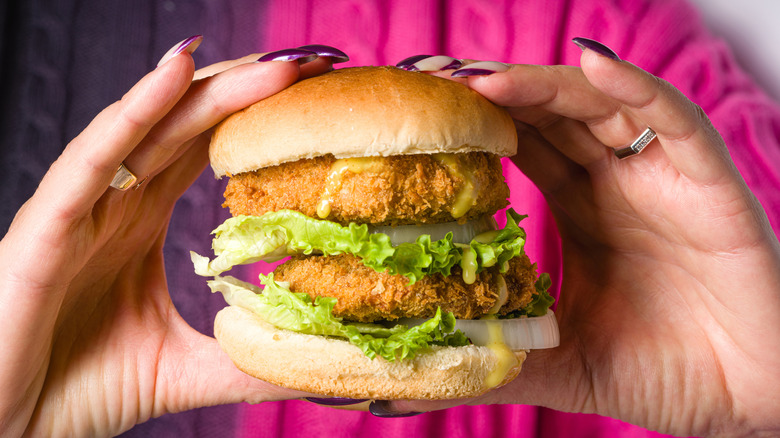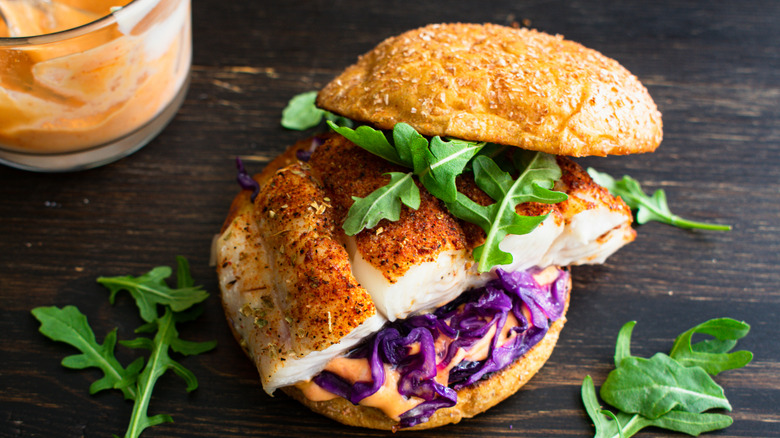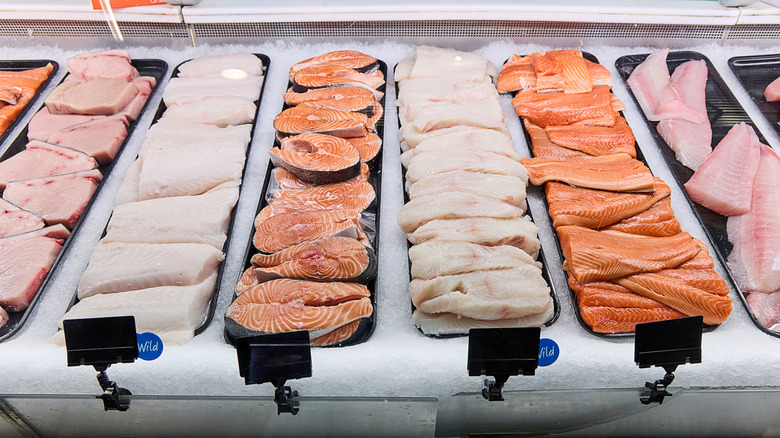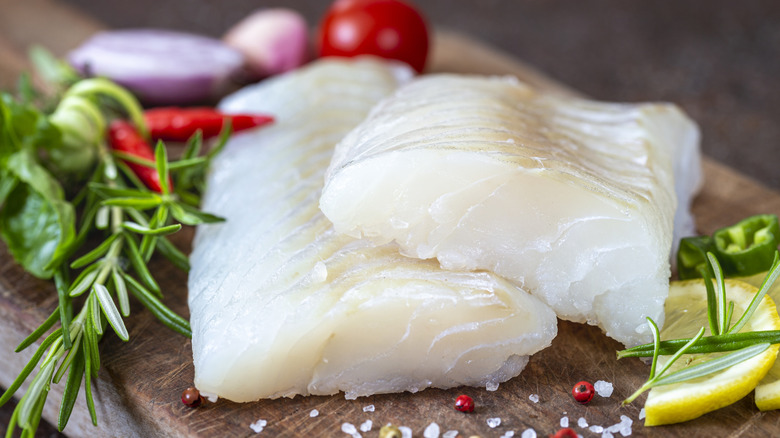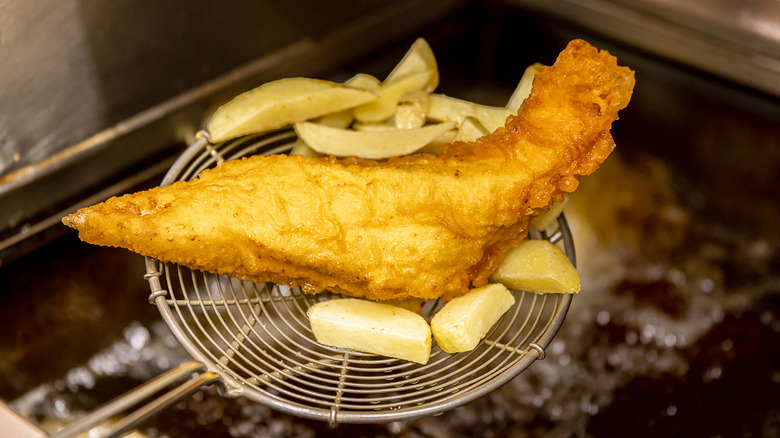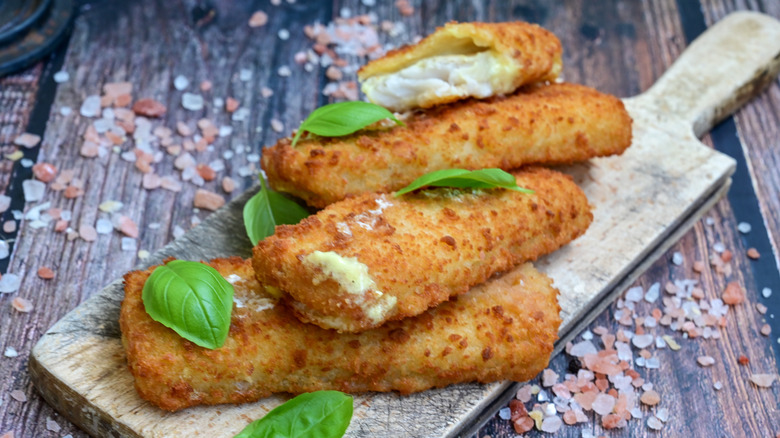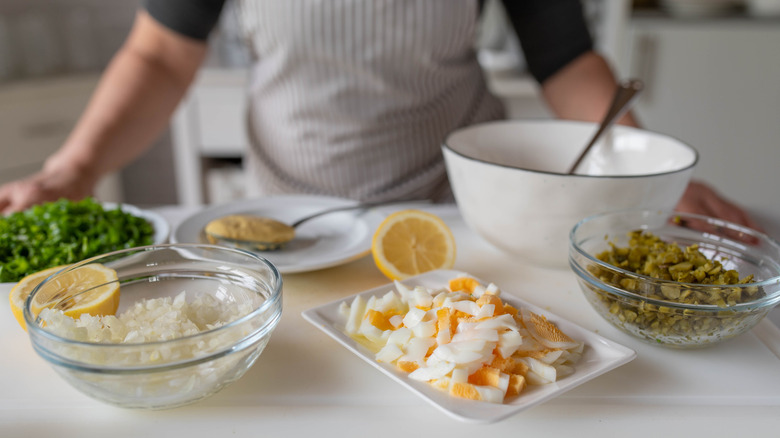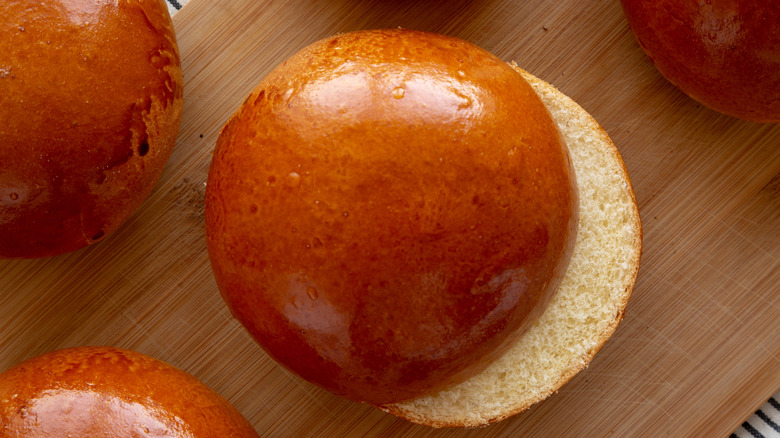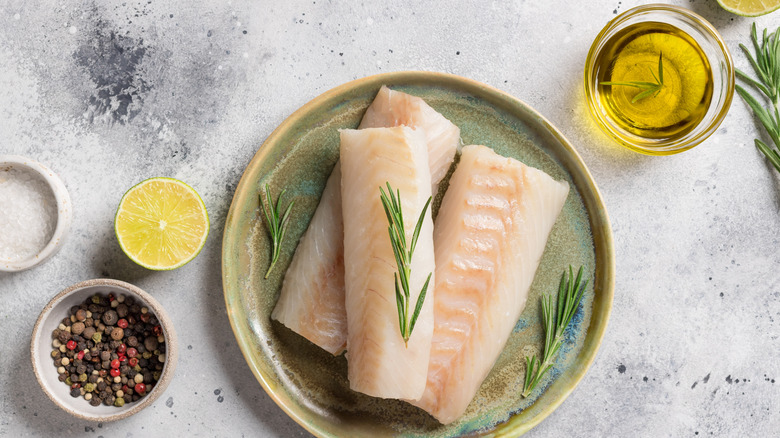Why Restaurant Fish Sandwiches Taste So Much Better Than Homemade, According To Chefs
Restaurants employ professional chefs and line cooks who put most novice home cooks to shame. Even if you fancy yourself somewhat of a decent cook, restaurants use lots of tricks and tips to make their food — well, more delicious — and this includes fish sandwiches of all kinds. Try as we may, our homemade fish sandwiches don't always live up to the ones you get from a restaurant. When done right, restaurant fish sandwiches are comforting, familiar, crispy, and rich, yet still taste bright and clean. So, how do they do it? Does it all come down to technique, or maybe it's the seasoning?
I checked in with a couple of experts, executive chef Jeff Tunks of Corvina Seafood Grill and executive chef Fergus Conneely of 26 Degree Brewery & Kitchen, to find out why restaurant fish sandwiches often beat amateur home cooks' attempts — and they definitely helped shed some light on the conundrum. Both chefs I consulted are based in Florida, so they are no strangers to top-notch seafood dishes and the joys of perfectly prepared fish sandwiches. Take a few tips from them and with any luck, your homemade version will not only blow your average fast food fish sandwiches out of the water, but give even the best restaurants a run for their money.
Restaurants know the importance of variety and lean into regional recipes
The term "fish sandwich" includes a wide variety of different recipes. In fact, this is one of the reasons chefs love them so much. As chef Fergus Conneely told me, fish sandwiches are a blank canvas: "I can play with flavors — add heat, brightness, pickles, or slaws." When chefs lean into their creative side, we wind up with spectacular dishes that often taste better than our homemade versions.
Chef Jeff Tunks agrees with Conneely and expanded on the idea by adding the various methods for cooking fish to the growing list of ways chefs play with the dish. You can fry, blacken, grill, or chill fish to make it into a salad for sandwiches, and more, "but the best is always focused on the freshest and usually the simplest, letting the main ingredient shine," said Tunks.
In addition to creative toppings and various cooking methods, chefs take inspiration from different cultures to ensure their fish sandwiches stand out in the best way. Chef Conneely is proof of this: "I've pulled inspiration from New Orleans po' boys, British fish butties, Japanese katsu sandos — every culture has its take, and that makes it fun to riff on." Many home cooks aren't as adventurous or confident enough to experiment with classic recipes, so it's no wonder homemade fish sandwiches don't always measure up.
Restaurants prioritize using the best, freshest fish, and they have access to a better selection
One of the main reasons restaurant fish sandwiches are so flipping tasty is that they use the best, freshest fish they can get their hands on — at least the really good ones do. This probably comes as no surprise, but starting with a premium cut of fish goes a long way when it comes to building a yummy sandwich. Many people don't splurge on the good stuff every time. As a result, our homemade fish sandwiches don't always live up to the stuff we are served in restaurants.
In addition, chef Fergus Conneely told me, "We've got access to better fish. Not to brag, but we get some pretty incredible product — super fresh, high-quality filets that make all the difference in taste and texture." So, even if you opt for the best fish you can find at the store, it may not be as good as the ones the pros have access to.
Restaurants also know what the best types of fish to use for a sandwich are, and they stick to them. Chef Jeff Tunks recommends "mahi, snapper, corvina, tuna (cooked rare), swordfish, or grouper if you can afford it." He also told me, "FYI, if you see a grouper sandwich on a restaurant menu and they are not charging at least $28 for it, most likely it's not grouper."
Restaurants know exactly what size fish filet is best for making sandwiches
In addition to using premium quality, fresh fish, restaurant chefs know that you need to use an appropriately sized filet to build a sandwich. Too big, and you're bread may not live up to the job. Too small, and it could easily get engulfed by the other toppings and sauces. However, when you use a perfectly sized filet of fish, all of the ingredients come together and balance each other out in expert fashion.
So, how big of a fish filet should you use? According to chef Jeff Tunks, the "ideal size is around 6 ounces." He also noted that the filet should be about ⅓ inch thick, boneless, and skinless. At home, it is easy to simply grab a filet and get going, but professional chefs understand that consistency is key. To ensure they get it right every single time, most restaurants weigh meat before portioning it out. You don't necessarily have to go that far, but aiming for Tunks' recommended size will serve you well.
Chefs know how to cook fish to perfection
There are many different ways to cook fish, and quite a few of them make for a yummy sandwich. However, whichever method is used, it needs to be done just right if you want to achieve the ideal flavor and texture. Chefs have cooking methods dialed in and, for the most part, pull them off perfectly every single time. Of course, there's bound to be some mistakes from time to time. Nobody is perfect, after all, but the pros have put in enough reps to confidently get it right. The same can't be said for novice chefs.
Chef Jeff Tunks likes to cook fish destined for a sandwich in a non-stick pan until it is lightly blackened. According to him, this method "adds flavor and punch but doesn't mask the flavor of the fish." There's no doubt that breaded and fried fish sandwiches are a true delight as well. Chef Fergus Conneely told me, "We deep-fry the fish just right — crispy on the outside, juicy on the inside." Whichever cooking method you choose for your next fish sandwich, just remember that practice makes perfect. Keep at it, and you'll master the art of cooking fish sooner than you think.
The pros season fish sandwiches generously
Seasoning is the key to making any dish burst with flavor, fish sandwiches included. While many of us think we add plenty of herbs and spices to our food at home, the pros could teach us a thing or two. They season everything, and they typically use more seasoning than we do, too. I don't know if you've ever seen a professional chef sprinkle salt on a dish, but they aren't messing around. The same can be said for other flavorings as well. The result? Drool-worthy food you're willing to pay a premium, restaurant price for.
When it comes to fish sandwiches specifically, chefs go hard on the seasonings. Chef Fergus Conneely told me, "The fish gets seasoned. The batter gets seasoned. The sauce? Seasoned. Even the fries and slaw on the side are seasoned. You're not getting that layered flavor at home unless you really go for it." So, if your fish sandwiches have been a bit lackluster as of late, upping the seasoning is a fantastic place to start turning them around. Go ahead and sprinkle some on, and then maybe add some more for good measure. Your taste buds will thank you.
Sauces made in-house blow the store-bought stuff out of the water
It's easy to default to store-bought sauces when cooking at home. Not only are they incredibly convenient, but many of them are pretty tasty, too. Even so, they don't stand a chance against a fresh, made-from-scratch sauce. Top-notch restaurants backed by quality chefs know there's no doubt homemade sauces are where it's at, so that's what they use on their fish sandwiches. If you don't, it's just one more reason why your recipes don't live up to restaurant perfection.
As chef Fergus Conneely told me, "Homemade sauces hit differently. Whether it's a tangy house tartar, spicy remoulade, or citrusy aioli, we make our sauces from scratch to cut through the richness of the fish and tie everything together." Even the way he describes it sounds tastier. Yes, please!
Tartar sauce and fish sandwiches are a dynamic duo, but there are also lots of underrated sauces you can use, a couple of which chef Conneely mentioned. Chef Jeff Tunks told me you can use "whatever fits your taste, but definitely have the acid, salt, and spice factor working." Obviously, if you opt for a homemade version as well, your fish sandwiches will taste even better.
Restaurants use the best bread for the job
We already know the type, freshness, and size of the fish you use to build a sandwich make a world of difference, so it only makes sense that you would opt for the best bread for the job as well. After all, you don't want to knock your carefully cooked fish down a peg or two at the last minute by dialing in the bread, right? Professional restaurant chefs would never dream of it, so you shouldn't either.
Chef Fergus Conneely told me point blank that the type of bread you use matters: "You can't just throw it on any bun. It's got to hold up to the heat and crunch without falling apart." He also stressed that a contrast of textures is paramount to a fish sandwich's success. His ideal is "flaky fish in a crackly crust, tucked into a soft, toasted bun. Simple but so satisfying."
Chef Jeff Tunks agrees with Conneely, and he specifically recommends using a buttered and toasted brioche bun because it has the soft, warm, and crispy texture that makes fish sandwiches shine. Anthony Bourdain may have hated using brioche buns for hamburgers, but as it turns out, they may just be the perfect choice for fish sandwiches.
Restaurants know what toppings make fish shine, and they know how to layer them
If you've ever looked at all of your fish sandwich fixings and wondered if there is a right and wrong way to layer them, you are not alone. Does the lettuce go on the top or the bottom? And what about the sauce and other toppings? Well, according to our experts, what toppings you use and how you situate them does, in fact, make a difference in the finished product.
Chef Jeff Tunks has a tried and true method for layering ingredients: "On the bottom to protect the sandwich from getting too soggy, I put tender bibb lettuce, very thin sliced red onion, thin sliced heirloom 'in season' tomato seasoned with coarse salt, and crisp sliced dill pickles," and then the fish goes on. After that, all that's left is to top it "with a good dollop of a seasoned mayonnaise-based dressing," and, of course, the top of the bun.
As far as what toppings you use, lettuce, tomato, onion, and pickle are pretty standard, but coleslaw makes a wonderful addition, too. According to chef Fergus Conneely, they work so well because of the hot-cold contrast. "There's something magic about hot fried fish layered with cool slaw, crisp lettuce, or a hit of pickle. It's that refreshing bite right after the crunch that keeps people coming back."
The pros know it all comes down to fat, salt, and balance in the end
According to chef Fergus Conneely, balance is everything when creating a restaurant-worthy fish sandwich: "Crispy, crunchy, soft, salty, tangy, fresh — when all those elements come together, it's magic." Adversely, if the flavors and textures aren't perfectly balanced throughout, there's no way it'll taste as good as the ones the pros make.
Chef Conneely also told me fat and salt should not be underestimated: "The honest truth? Fat and salt make everything better." Restaurant chefs like him deep fry the fish, adding fat and texture, and of course, they aren't shy with the seasoning either. "Salt brings everything to life," said Conneely, and balancing it with the other elements is key. This perfect balancing act isn't second-nature for amateur home cooks, but it is for chefs like Conneely. It's understandable if you haven't mastered the technique just yet. Keep practicing, though, and before you know it, you just might be able to keep up with the pros.
Professional chefs know the importance of pairing their fish sandwiches with the right drink
In addition to crafting a fish sandwich just right, what you drink along with it matters. Professional chefs are experts at pairing flavors, so choosing the perfect drink to go along with their fish sandwiches is almost second nature. For all of us amateurs at home, the process isn't always so straightforward. However, you'll be glad to know it all boils down to your personal preference in the end.
Chef Jeff Tunks told me he likes to wash his fish sandwiches down with an ice-cold IPA. If you aren't a fan of the overly hoppy flavor of IPAs, lighter ales and other beers also make a safe bet. Citrus in particular pairs wonderfully with fish as well, so farmhouse ales and sauvignon blancs are obvious picks as well. Or, if you are looking for a more family-friendly option, good old-fashioned lemonade won't let you down.
No matter what you drink alongside your fish sandwich, chef Fergus Conneely says it all comes down to that first bite: "You know what I'm talking about — the audible crunch, the steam escaping the fillet, the sauce hitting your taste buds. That first bite is what makes it all worth it." Follow Tunks and Conneely's pro tips, and achieving this heavenly first bite in your homemade fish sandwiches will be well within your reach.

